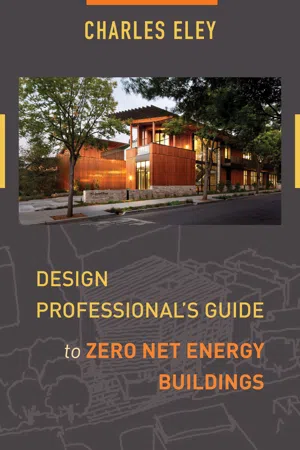
- 272 pages
- English
- ePUB (mobile friendly)
- Available on iOS & Android
Design Professional's Guide to Zero Net Energy Buildings
About This Book
In the United States, direct energy use in buildings accounts for 39% of carbon dioxide emissions per year—more than any other sector. Buildings contribute to a changing climate and warming of the earth in ways that will significantly affect future generations. Zero net energy (ZNE) buildings are a practical and cost-effective way to reduce our energy needs, employ clean solar and wind technologies, protect the environment, and improve our lives. Interest in ZNE buildings, which produce as much energy as they use over the course of a year, has been growing rapidly.In the Design Professional's Guide to Zero Net Energy Buildings, Charles Eley draws from over 40 years of his own experience, and interviews with other industry experts, to lay out the principles for achieving ZNE buildings and the issues surrounding their development. Eley emphasizes the importance of building energy use in achieving a sustainable future; describes how building energy use can be minimized through smart design and energy efficiency technologies; and presents practical information on how to incorporate renewable energy technologies to meet the lowered energy needs. The book identifies the building types and climates where meeting the goal will be a challenge and offers solutions for these special cases. It shows the reader, through examples and explanations, that these solutions are viable and cost-effective.ZNE buildings are practical and cost-effective ways to address climate change without compromising our quality of life. ZNE buildings are an energizing concept and one that is broadly accepted yet, there is little information on what is required to actually meet these goals. This book shows that the goal is feasible and can be practically achieved in most buildings, that our construction industry is up to the challenge, and that we already have the necessary technologies and knowledge.
Frequently asked questions
Information
Table of contents
- Cover
- Title Page
- Copyright
- Contents
- Preface
- Acknowledgments
- 1. Introduction: We Have But One Earth
- 2. Smart Building Design: Contextual Design, Energy Efficiency, and Curtailment
- 3. Here Comes the Sun: The Future of Renewable-energy Systems
- 4. Energy Modeling: Evaluating ZNE before the Utility Bills Arrive
- 5. Making It All Work: Integrated Project Delivery, Commissioning, Intelligent Controls, and Mobile Devices
- 6. Metrics and Boundaries: What Exactly is a Zero Net Energy Building?
- 7. ZNE for the Mainstream: Scaling up the Concept
- 8. Beyond ZNE: The World of Our Grandchildren
- Appendix: Examples of ZNE and Energy-efficient Buildings
- Endnotes
- Index